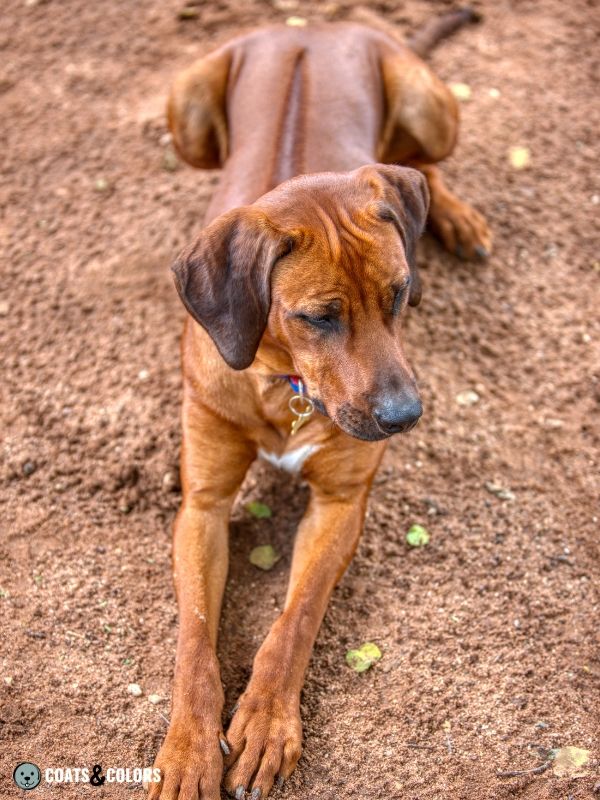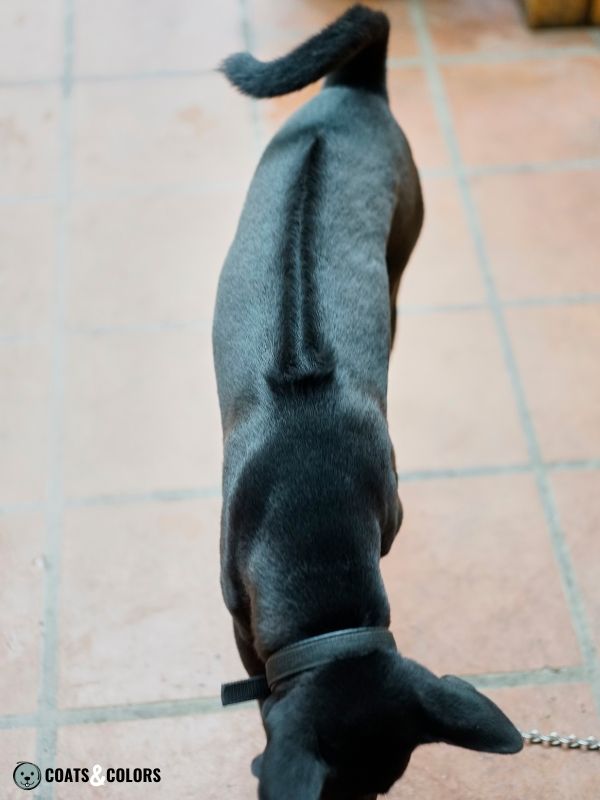Some dog breeds such as the Rhodesian Ridgeback or the Thai Ridgeback are famous for the eponymous ridge on their back. We are talking about the hard-to-overlook ridge of hair on their back that grows in the opposite direction. But how do Ridgebacks get their ridge?
What Is A Ridgeback?
Some breeds have a dorsal stripe of hair that grows in the opposite direction than the rest of its coat. Sometimes the direction of growth is not fully inverted but still clearly twisted.
This area of backward-growing hair is called a ridge. Ridges can vary in shape, length or width.
On a Rhodesian Ridgeback’s back, an ideal ridge according to the breed standard, starts just behind the shoulder blades and continues without any gaps all the way to a point between the hip bone.

A short or partial ridge is considered a serious fault in this breed.
Some dogs may have longer ridges that span a significant portion of their back while others may have shorter ridges or gaps in their ridge. Similarly, the width of the ridge can range from narrow to broad.
Ideally, ridges should have a width of about 5 cm or 2 inches. The point between the shoulders should be the widest part of the ridge which then evenly tapers toward the haunches.

The ridge should be symmetrical with not more or less than two identical hair whorls opposite each other. The breed-specific term for these circular swirls of hair is “crowns“.
Typically, these hair whorls occur when the fur in the left crown rotates counter-clockwise and the hair in the right crown swirls clockwise.

Just above the crowns, at the top of the ridge, there is a slightly broadened area covered in backward-growing hair. This “fan” or “box” varies in shape from dog to dog and can be roundish, flat or elongated. Any box shape is acceptable as long as it is symmetrical and not too long since the crowns should not extend further down the ridge than one-third of its length.
Slightly offset crowns with a minimally asymmetrical fan still pass as acceptable for the show ring although not ideal. But badly offset crowns or too much overall asymmetry are considered an abnormality and undesirable.

In Thai Ridgebacks, the variety of ridge shapes is much larger. Their breed standard just demands that the ridge should be symmetrical and not get too wide. Whorls at the top of the ridge are acceptable.
The Ridge Allele
The breed-defining dorsal hair ridge is linked to a mutation on dog chromosome 18. To be more specific, a mutation in which a large DNA segment with 133.400 base pairs has been duplicated[1].
Because the duplicated region is quite large it encompasses three fibroblast growth factors (FGF ).
Genes of this family are known to play diverse roles in regulating cell proliferation, migration and differentiation during embryonic development[8]. So the ridge might be caused by dysregulation of one or more of the three FGF genes during development[1].
The same mutation has been found in Thai Ridgebacks, not just in Rhodesian Ridgeback genetics!
The ridge mutation R is dominant over the wild-type ridgeless allele r:
This makes the dorsal ridge in dogs an autosomal dominant trait.
To produce a ridge, a dog has to have just one copy of R.
But without genetic testing, homozygous dogs with two copies of the R allele (R/R) are indistinguishable from heterozygous dogs (R/r) with just one copy[5].
This is a problem for breeders because the ridge is the flagship trait of their respective breeds. They try to avoid mating two carriers (R/r x R/r) and by doing so accidentally producing ridgeless puppies, as these cannot enter the show ring or be used for breeding.

One interesting fact about ridgeback genetics is that this trait only has near-complete penetrance. All homozygous dogs (R/R) have a ridge. But, for unknown reasons, as many as 4-8% of heterozygotes (R/r) might actually be ridgeless[3].
And another thing ridgeback breeders need to consider is that homozygous dogs (R/R) are at greater risk for the development of dermoid sinus[5]. Additionally, ridge anomalies such as multiple crowns also seem to happen more likely in dogs with two copies of the ridge gene[3].
Ridge Locus Calculator
This simple tool can help you predict different ridgeback dog genetics:
Ridgeback And Health
Ridgebacks with two copies of the ridge allele (R/R) are at risk for dermoid sinus while this happens rarely in dogs with just one copy (R/r) and almost never in ridgeless dogs (r/r)[1,3,4,5].
This makes it a more or less prevalent condition in all of the ridgeback breeds. But it also happens sporadically in other dog breeds as a congenital defect.
A dermoid sinus is a skin condition, a tube-like structure that extends from the surface of the skin into deeper layers. The dermoid sinus is typically found along the midline of the dog’s back, just above, below, or within the ridge area.
But it can also happen on the dog’s head[9].

The dermoid sinus forms during embryonic development when there is a failure of separation between tissue layers. This abnormality leads to the formation of a tract lined with skin tissue.
Affected dogs may exhibit a small dimple, a cord-like structure or a small hole in their skin. Dermoid sinuses can vary in severity with some being very shallow and inconsequential.
But, because in its center it contains hair and sebum, it can become infected and cause more serious health issues such as abscesses or sepsis.
Not too long ago, some breed clubs advised their members to just cull affected puppies (as well as ridgeless puppies) which, rightfully so, raised some ethical concerns about breeding ridgebacks.

Code of Ethics 2006

Code of Ethics 2019
Early detection and diagnosis of dermoid sinuses are crucial to prevent complications. Surgical removal is the recommended treatment, typically involving the complete excision of the sinus tract to eliminate the risk of infection and potential neurological complications.
Breeders and owners of Rhodesian Ridgebacks should be aware of this condition and work closely with veterinarians to identify and manage dermoid sinuses in affected puppies.
While the ridge gene is considered a predisposing genetic factor, the ridge gene (R) may not actually be causal for dermoid sinuses[6,7]. Newer research indicates that this condition may have a more complex genetic basis and can be selected against without losing the dorsal hair ridge.
Ridgeback Dog Breeds
The ridge may have originated in Asian or African landraces such as the Cambodian Razorback or the Hottentot Khoi dog which is believed to be involved in the creation of the modern Rhodesian Ridgeback.
Today, there is only a small number of dog breeds that come with a ridge. The causal mutation was found in all of them making it likely that it came from a common ancestor.
Rhodesian Ridgeback

Overall, the ideal ridge of a Rhodesian Ridgeback dog has three components, a box between the shoulders, two symmetrical and at most slightly offset crowns as well as a tail tapering towards the hips.
Earlier breed standards also recognized other ridge shapes such as a fiddle ridge with 3-4 crowns[2]. But then someone decided that only ridges with two crowns were acceptable.
The ridge […] should start immediately behind the shoulders and continue to a point between the prominence of the hips and should contain two identical crowns (whorls) directly opposite each other. The lower edge of the crowns (whorls) should not extend further down the ridge than one third of the ridge.
Breed Standard
Thai Ridgeback

This tough and loyal hunting dog from the eastern parts of Thailand is considered a primitive old breed of dog. Their short coat comes with a large number of possible colors.
Thai Ridgebacks also accept a lot of variation in ridge phenotype, they often come with broad ridges or multiple crowns. In show dogs, a symmetrical and not too unbalanced ridge is preferred.
The ridge […] should be clearly defined from other parts of the back. There are various shapes and lengths of ridge, but must be symmetrical on either side of the backbone and within the width of the back. Crowns or whirls at the head of the ridge are acceptable.
Breed Standard
Phu Quoc Ridgeback

This muscular and confident dog is a smallish landrace from the island of Phú Quốc in Southern Vietnam. it is currently not accepted as a dog breed by the major breed clubs.
Ridge shapes can be quite variable.
The color of the hair on the ridge may be darker than the rest of the body. The shape of the ridge can vary but should be symmetrical through the spine and cover a length of at least 2/3 of the back. If present, the crown or crowns are symmetrical and are typically located at the top of the ridge. Multiple crowns on the ridge are accepted if they are symmetric through the spine.
Phu Quoc Ridgeback Kennel Club
Ridge Locus Testing
Before genetic testing for the ridge trait was possible, there was a small number of ridgeless puppies born each year. Breeders had to rely on pedigree analysis to spot carriers (R/r) in their breeding[4].
A small percentage (<10%) of dogs with one copy (R/r) of the ridge mutation do not express a ridge.
| Mating | R/R | R/r | r/r |
|---|---|---|---|
| R/R x R/R | 100 % | – | – |
| R/R x R/r | 50 % | 50 % | – |
| R/R x r/r | – | 100 % | – |
| R/r x R/r | 25 % | 50 % | 25 % |
| R/r x r/r | – | 50 % | 50 % |
| r/r x r/r | – | – | 100 % |
Links
[1] Hillbertz et al (2007). Duplication of FGF3, FGF4, FGF19 and ORAOV1 causes hair ridge and predisposition to dermoid sinus in Ridgeback dogs. Nat Genet. https://doi.org/10.1038/ng.2007.4
[2] Hillbertz (2007): The Origin of the Ridge and Associated Anomalies in Rhodesian Ridgebacks. Doctoral Thesis. Swedish University of Agricultural Sciences. https://pub.epsilon.slu.se/1669/1/Salmon_Hillbertz.pdf
[3] Ridge Gene Testing Lecture (pdf). Rhodesian Ridgeback World Congress 2016, Sweden. © GenoCan
[4] Hillbertz & Andersson (2006). Autosomal dominant mutation causing the dorsal ridge predisposes for dermoid sinus in Rhodesian ridgeback dogs. J Small Anim Pract. http://dx.doi.org/10.1111/j.1748-5827.2006.00016.x
[5] Waldo & Diaz (2015). Development and validation of a diagnostic test for Ridge allele copy number in Rhodesian Ridgeback dogs. Canine Genet Epidemiol. http://dx.doi.org/10.1186/s40575-015-0013-x
[6] Distl (2022). Prevalence and segregation analysis of dermoid sinus in Rhodesian Ridgebacks. The Veterinary Journal. https://doi.org/10.1016/j.tvjl.2022.105803
[7] Zhang & Distl (2022). A study of Rhodesian Ridgeback dogs indicates that the duplication responsible for hair ridge is not identical with the hypothesized locus for dermoid sinus. Anim Genet. https://doi.org/10.1111/age.13172
[8] Ornitz & Itoh (2001). Fibroblast growth factors. Genome Biol. https://doi.org/10.1186/gb-2001-2-3-reviews3005
[9] Nihan DİKBAŞ, Ebru ERAVCI YALIN. Characterization of the Nasal Dermoid Sinus in A Rhodesian Ridgeback Dog with Computerized Tomography and Magnetic Resonance Imaging. Kafkas Univ Vet Fak Derg, 29 (2): 207-211, 2023. DOI: 10.9775/kvfd.2022.28663

Hi! I’m Steffi. I am a biologist and a big time dog nerd. You are curious about coat color genetics? You’ve come to the right place! Read more.







